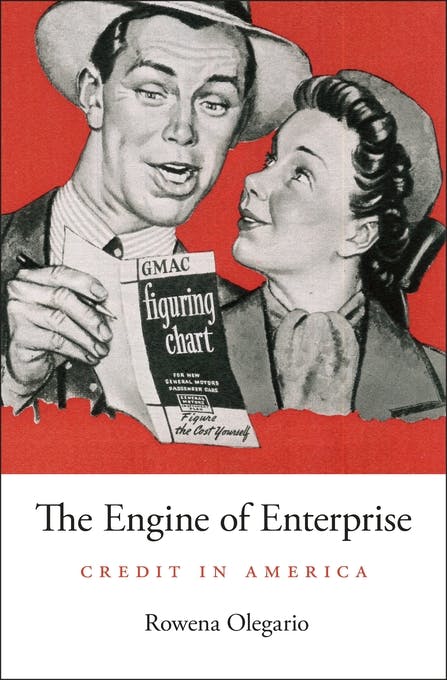One of the reasons I think some conservatives get so angry when histories are given identity qualifiers—whether Black History Month or scholarly books with “women and” in the title—is that they cast aspersion on the general category. History with a capital-H becomes just white history or men’s history or white men’s history. To smooth over this inconvenient past, unqualified American History has projected a post-civil-rights subject backward, judiciously adding “and her” or “they didn’t mean black people, but we do” when they’re necessary to universalize the Founders’ lofty (but not that lofty) proclamations. But that’s revisionism, and it deserves its own qualifier too. I think we should call it Business History.
The Engine of Enterprise: Credit in America by Rowena Olegario is an exemplary piece of business history. Olegario, a Senior Research Fellow at Oxford University’s Saïd Business School, takes the reader through centuries of American finance policy and practices. History here is the dance between government and industry, the two actors whose rhythm and harmony create national prosperity. Creditors innovated this mechanism, took that risk, government backed those loans, regulated these excesses, back and forth and so on and so on until America is the world’s superpower. The book treats the actual people who live in the United States like a single giant Tamagotchi, the population generating outputs for the real actors to handle.
The thesis of Olegario’s book, an idea she repeats often, is that credit built America. If a professor were teaching the Marxist concept of reification, they could not find a better example. In the book’s vision, a thing (credit) becomes the builder, while people are turned into material. But credit did not build America, labor built America, and of labor The Engine of Enterprise tells us almost nothing. The book has little to offer as an engaging or useful national history, but a lot as a detailed demonstration of its own impoverished method.
The battle between Alexander Hamilton and Thomas Jefferson over the national bank sets the book’s central tension: To a creditor or debtor be? While Hamilton wanted a national bank and a government backed credit system, Jefferson argued that the plan wouldn’t work and the feds lacked the authority in the first place. It was never really a contest, and Olegario sides with Hamilton’s farsightedness. But this is one of the few places where the book descends to the human level, and the author is laughably generous with Jefferson. Whether his opposition to debt was more personal or ideological is up for debate, but to say the slave-breeder’s “unyielding dedication to human liberty placed him among the most radical thinkers of the age” is false. To earnestly repeat the child salesman Jefferson’s anti-debt line to James Madison about no generation having the right to bind future ones, obscene.

Olegario’s treatment of Jefferson does not bode well for black Americans in her story. Slavery gets extremely short shrift in the narrative, meriting only a scant handful of mentions. In a paragraph on the early 19th century financiers Brown & Sons, Olegario is curiously defensive, writing “They also no doubt helped planters to buy slaves.” Since they were financing the growth of the southern cotton industry there could be no doubt; slaves were the labor, and the circuit doesn’t function any better without them than without credit. But the book’s narrative is progressive: Credit builds America, and both are good. Slavery is bad, so it must be reduced to an awkward “Also: slavery. Sad.” interjection, despite the institution’s central importance to the fledgling nation’s credit system.
In Cornell Historian Edward Baptist’s book The Half That Has Never Been Told: Slavery and The Making of American Capitalism, he writes of the same events from a different perspective. “For enslaved people like Rachel, the sudden growth in financial confidence did not mean liberation, but the opposite. The bank [of the United States] helped both white Americans and overseas investors to have faith in a future in which the debts of slave buyers would be paid off by ever-growing revenues from the cash-earning commodities that industrializing Britain wanted.” This confidence (and the heavily financed Louisiana Purchase) propelled the spread of slavery west, which supported prices for slave breeders in Virginia and Maryland.
Baptist writes of slave drivers expanding American infrastructure “searching out ways to extract new yield from human energy stored in the slave cabins of Virginia’s Southside.” Olegario mentions that it was the forced labor of black slaves drawing all this investment—and often their very bodies backing the debt—only in retrospect, after the Civil War is over. It’s whitewashing. No legitimate history of antebellum American credit can skip over what slaves were owed and the role of that unpaid debt in the building of national wealth.
Cause and effect is a constant problem in The Engine of Enterprise. Whenever the finance system fails it’s mainly attributable to a mistake in federal management. The Great Depression was caused by the Federal Reserve failing to offer interest, pushing member banks toward Wall Street. The 2008 crisis was the fault of Government Supported Entities like Freddie Mac. When the economy is great, it’s because of innovative financiers and their good buddies in the federal government. Labor—as a class and as an organized political force—is pushed to the background. At the end of a section on installment credit and the growth of the durable consumer goods market in the first half of the 20th century, Olegario writes that “People consumed more and took on more debt, but good wages and low inflation allowed them to save.” The root of credit is once again labor, but as to where those good wages came from (decades of organized struggle and increased worker productivity), Olegario is mum.
As with slavery, the book constantly has to negotiate the embarrassing potholes in America’s past. At the same time, Olegario is focused on the bottom line: the growth of American GDP and business profitability. If it sells, it counts. But being proud of building the suburbs is old-fashioned, and Olegario concedes as much: “Cultural critics such as William Whyte expressed ambivalence about the spread of the suburbs, and academic studies have rightly pointed to the casual racism that underpinned much of the suburban ideal.” But, in an exemplary example of Business History, Olegario immediately pivots: “But millions of Americans embraced the chance to own newer, larger homes and to raise their children in what they perceived to be a healthier environment outside of the city centers.” This is most charitable description of white flight I can imagine, but it’s still unclear why installment agreements and federally supported mortgages deserve more credit than the scary black people and their incredible ability to stimulate white consumer demand.
The book hews to a quantitative, almost robotic system of historical appraisal. Economic growth and popular wellbeing are taken to be one and the same, or at least they are discussed as thought they ought to be. Credit bridges the gap between what we have and what we will have, and if some individuals or groups don’t have as much or enough, then, well, you look at things as a whole. This simplistic, amoral methodology doesn’t make for good history, or good reading for that matter. As a complete narrative, The Engine of Enterprise is an excuse for the American project, and it’s not very good at that either. Global warming alone could sour the author’s enthusiasm.
Twice Olegario mentions the last few decades of stagnant (read: falling) wages, but what credit has to do with that we never hear. We don’t hear about education loans pushing the costs of job training onto workers, or heavily leveraged corporate capital improvements that automated away union jobs. Credit is also a word for responsibility, but Olegario adopts the investor’s perspective: It doesn’t matter where the money comes from as long as it fulfills expectations. Money from cotton from slavery is money.
Willful blindness is a powerful tool, for investors and historians alike. The Engine of Enterprise lacks a lot of the pathos we’re accustomed to in American History, but the story is pretty much the same. Some smart brave guys started a country, and with a mix of hard work and con artistry, their children conquered the continent and created the most prosperous nation in the world. There are ups and downs, but the constant long-term trend is growth and progress. Business Historians offer the purest version of the narrative, but liberals and conservatives alike still pledge allegiance to the same story.
Dred Scott v. Sandford—the 1856 Supreme Court case that reaffirmed the legality of slavery and the property status of slaves—is infamous as probably the worst legal decision in American history. That the decision reassured creditors, propelled speculation, and shielded the South from the Panic of 1857 should be no consolation. The point of history isn’t to affix “good” and “bad” labels to people or events, but the exploitation and pain that people experience must be reckoned with, it has to count. The honest plural of harm cannot simply be prosperity.
In his majority ruling in Dred Scott, Chief Justice Roger B. Taney offered a surprisingly strong rebuke to the business historians who would universalize the founders’ liberalism post-hoc. Taney quoted the Declaration of Independence’s famous words:
We hold these truths to be self-evident: that all men are created equal; that they are endowed by their Creator with certain unalienable rights; that among them is [sic] life, liberty, and the pursuit of happiness; that to secure these rights, Governments are instituted, deriving their just powers from the consent of the governed.
These are some of the lines that provide foundation for Olegario’s high appraisal of Jefferson and his principled anti-debt stance. But Taney—born less than a year after the Declaration—would have no revisionism:
The general words above quoted would seem to embrace the whole human family, and if they were used in a similar instrument at this day would be so understood. But it is too clear for dispute that the enslaved African race were not intended to be included, and formed no part of the people who framed and adopted this declaration, for if the language, as understood in that day, would embrace them, the conduct of the distinguished men who framed the Declaration of Independence would have been utterly and flagrantly inconsistent with the principles they asserted, and instead of the sympathy of mankind to which they so confidently appealed, they would have deserved and received universal rebuke and reprobation.
Taney resolved the contradiction by doubling down on white supremacy. How have we resolved it? Business History gives the founders credit—not responsibility for their actions or beliefs, but a bridge between what they had and what they would have. The country has yet to pay off this debt, and the bill is long past due.
